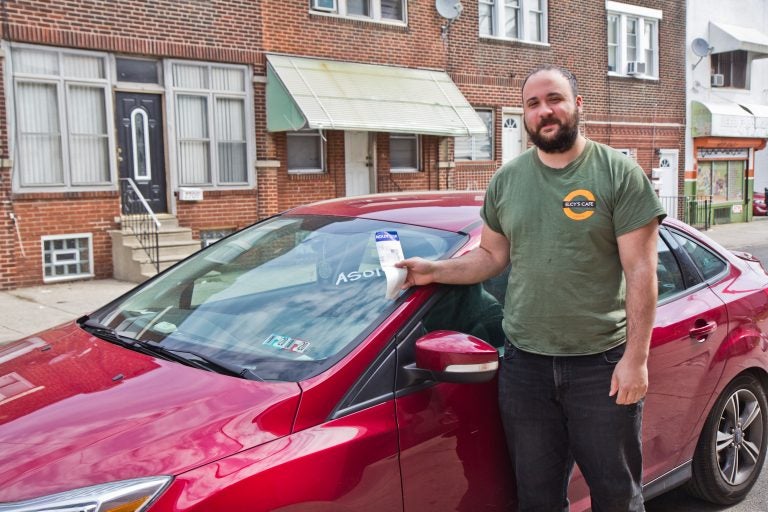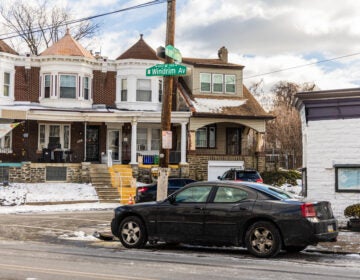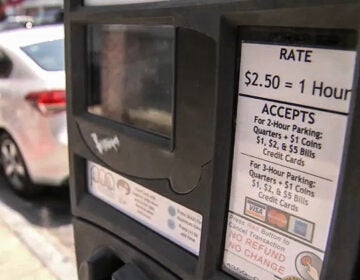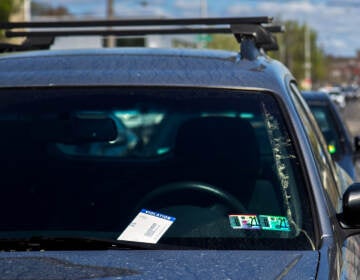Drivers from these gentrifying Philly neighborhoods get the most parking tickets
PPA data indicates that not all drivers are created equal: Residents from five gentrifying ZIP codes near Center City receive tickets at a higher rate than anyone else.
Listen 2:57
Mark Rascati has been a Philadelphia resident for 3 years. He delivers for Instacart and frequently runs into problems with parking and recently had his car towed. (Kimberly Paynter/WHYY)
This article originally appeared on PlanPhilly.
—
Mark Rascati hates parking in Center City. He delivers groceries for a living, so he does it a lot. Too often — even though he lives a mile away.
The trips haven’t come cheap. Since the 28-year-old moved to South Philadelphia’s 19146 zip three years ago from Virginia, he estimates he’s paid $2,000 worth of tickets.
“They must have like a sixth sense,” he said of the Philadelphia Parking Authority’s downtown patrol officers. “They must smell out cars who might be parked wrong.”
PPA data shows that Rascati’s misery has plenty of company. WHYY obtained records that reveal, for the first time, where ticketed drivers live — specifically, the ZIP code where each driver’s vehicle is registered. The data indicates that not all drivers are created equal: Residents, like Rascati, from five gentrifying ZIP codes near Center City receive tickets at higher rates than anyone else.
These records, covering some 9 million parking tickets issued between 2007 and 2017, also show these drivers were most likely to be ticketed while parked downtown, as opposed to elsewhere in the city.
The worst of the worst were drivers from the 19146 ZIP code, which encompasses Southwest Center City, half of Point Breeze and Grays Ferry. Here, drivers paid out $25 million for more than half a million parking tickets over ten years, the equivalent of nearly 15 tickets for each of the 35,000 residents in those areas.
When drivers from the 19146 ZIP code were caught at expired meters or in a no parking zone — by far the two most common infractions — they were usually downtown. Fully 71 percent of these tickets were issued in Center City, compared to 47 percent for all drivers citywide.
Erick Guerra, an urban planning professor at the University of Pennsylvania, described the pattern as a reflection of Center City’s “gravitational pull.”
“Center City has a lot of jobs, a lot of shops, a lot of restaurants,” he said. “And if you’re in a dense, residential neighborhood that’s relatively close to it, you’re more likely to go there than if you kind of live further afield. And you’re more likely by foot, by bike, by transit and by car.”
But there is another layer there and it has to do with socioeconomics.
The Fairmount neighborhood saw about 11 parking tickets for every resident, one of the highest rates in the city. But head just north of Girard Avenue — the traditional dividing line between majority-black and majority-white neighborhoods in North Philadelphia –– and the pattern disappears.
Just north of this line, ZIP codes with higher poverty rates saw the equivalent of just four tickets for every resident. Head due east, to booming Fishtown, and ticketing rates ratchet back up. In deep South Philly, residents to the east of Broad Street received tickets at a much higher rate than those from the comparatively poorer ZIP code immediately to the west.
Further afield, like Manayunk and East Falls, which have both seen influxes of transplants over the past few decades also received tickets at a high rate.
So why do ticketing patterns seem to follow the same path as gentrification? More well-off residents are simply more likely to own cars, Guerra says. And they’re more likely to use them to visit the upscale services and white collar jobs downtown, PPA officers be damned.
“A lot of neighborhoods, despite being relatively close to downtown and well-served by transit, have fairly high car ownership rates and part of that relates to income,” he said. “Poorer neighborhoods generally have lower car ownership rates per adult. And I would also suspect lower probability of going to Center City for a restaurant or for work than someone living a bit further south.”
Residents living in Center City itself had comparatively low rates of ticketing –– a reflection of lower rates of car ownership and walkability. But living adjacent to Philadelphia’s downtown should also provide those same residents easy, car-free access to shops and jobs in Center City, compared to more outlying neighborhoods. After all, renters and homeowners alike pay a premium to live within a short walk or ride of its offices, shops and restaurants.
Anita Cozart, an urban planner who promotes equitable transportation and development policy at PolicyLink, a national think tank, says class differences again play a role here as well. Wealthier residents may decide its simply worth it to gamble on getting the occasional ticket, compared to gambling on the frequency or reliability of buses or the subway.
“Folks who are more affluent may just do the calculation and say that it is for them, their time and their convenience, it’s worth it to drive versus taking public transportation,” Cozart said.
Paying a premium for transit-access yet choosing to drive
Transit advocates also say the PPA data is more proof that Philadelphia is failing to coax residents in its most densely packed neighborhoods out of their cars. Dena Driscoll, a co-chair of the urbanist PAC 5th Square who has lived in South Philly for more than a decade, said she was frustrated, but not surprised, that so many of her neighbors were driving downtown.
“We know Council President [Darrell] Clarke stated, you know, ‘We live in Philadelphia, where people drive to the corner store.’ And Center City certainly isn’t the corner store, but people are driving there,” Driscoll said. “We really need to think as a city, collectively, how we reduce people who could be taking public transportation from driving.”
Driscoll also suspected that more lax parking laws in South Philly itself — a place where drivers have illegally parked on the South Broad Street median with few repercussions –– may lead to more residents getting ticketed when they leave the neighborhood.
“In South Philadelphia, our Council people make it easier to block crosswalks and curb cuts. We ask the PPA to be lenient on them instead of enforcing that and then they think they can do that in Center City,” she said. “But the rules in South Philadelphia need to be the same rules in Center City.”
To some measure, data reflects the suspicion that South Philly drivers are taking their bad habits with them around the city. While nearly all gentrifying ZIP codes showed above average ticketing rates, drivers from South Philadelphia were far more likely to be ticketed for parking in a prohibited space downtown, like a crosswalk or curb cut, than their counterparts in Fishtown or Fairmount.
But Guerra said the overall pattern –– of those in more accessible neighborhoods still opting to drive downtown –– were unlikely to change unless the city radically reevaluated the economics of public street parking, even if that entailed pricier meter rates or costlier tickets.
“Part of it is actually just that [street] parking is really underpriced. These people are choosing to get tickets as opposed to paying to go in a garage,” Guerra said. “It’s really easy, if you want, to drive from South Philadelphia to Center City…For a lot of people, they view it as a cost of doing business.”
For his part, Guerra says he personally likes to walk downtown from his home in Northern Liberties. But he doesn’t begrudge people, like Rascati, who simply can’t avoid driving.
“People have a lot of reasons to drive. Driving is tremendously helpful. Try taking the bus with five kids,” he said. “It’s not that much fun.”
WHYY is your source for fact-based, in-depth journalism and information. As a nonprofit organization, we rely on financial support from readers like you. Please give today.








